 | | | Switch to: Europe, USA, New Zealand, Antarctica Credit: NOAA/Ovation  Planetary K-index Planetary K-index
Now: Kp= 1 quiet
24-hr max: Kp= 3 quiet
explanation | more data
Interplanetary Mag. Field
Btotal: 5.2 nT
Bz: 3.2 nT north
more data: ACE, DSCOVR
Updated: Today at 2348 UT  Coronal Holes: 24 Aug 18 Coronal Holes: 24 Aug 18 
Solar wind flowing from this northern coronal hole could brush Earth's magnetic field on Aug. 25th. Credit: SDO/AIA  Noctilucent Clouds The season for noctilucent clouds in he northern hemisphere is underway. Check here daily for the latest images from NASA's AIM spacecraft. Switch view: Europe, USA, Asia, Polar Updated at: 08-24-2018 14:55:04 Noctilucent Clouds The season for noctilucent clouds in he northern hemisphere is underway. Check here daily for the latest images from NASA's AIM spacecraft. Switch view: Europe, USA, Asia, Polar Updated at: 08-24-2018 14:55:04  SPACE WEATHER
NOAA Forecasts | | Updated at: 2018 Aug 24 2200 UTC FLARE | 0-24 hr | 24-48 hr | CLASS M | 01 % | 01 % | CLASS X | 01 % | 01 % |  Geomagnetic Storms: Geomagnetic Storms:
Probabilities for significant disturbances in Earth's magnetic field are given for three activity levels: active, minor storm, severe storm Updated at: 2018 Aug 24 2200 UTC Mid-latitudes | 0-24 hr | 24-48 hr | ACTIVE | 35 % | 25 % | MINOR | 15 % | 10 % | SEVERE | 01 % | 01 % | High latitudes | 0-24 hr | 24-48 hr | ACTIVE | 10 % | 15 % | MINOR | 25 % | 25 % | SEVERE | 50 % | 35 % | | | |  | | | | | | | | | | | Lights Over Lapland has a brand-new website full of exciting adventures in Abisko National Park, Sweden! Take a look at our aurora activities and book your once-in-a-lifetime trip with us today! | | | WEAK CME IMPACT POSSIBLE TODAY: Geomagnetic unrest is possible later today or tomorrow when a coronal mass ejection (CME) might hit Earth's magnetic field. The CME, which left the sun on Aug. 21st, is faint and slow-moving--and there's a fair chance it will miss altogether. Nevertheless, CMEs carry relatively strong magnetic fields so even a glancing blow could spark Arctic auroras. Free: Aurora Alerts. A GREEN COMET APPROACHES EARTH: Comet 21P/Giacobini-Zinner is approaching Earth. On Sept. 10th, it will be 0.39 AU (58 million km) from our planet and almost bright enough to see with the naked eye. Already it is an easy target for backyard telescopes. Last night, Michael Jäger of Weißenkirchen, Austria, caught the 7.7th magnitude comet passing through star cluster Tombaugh 5 in the constellation Camelopardalis: 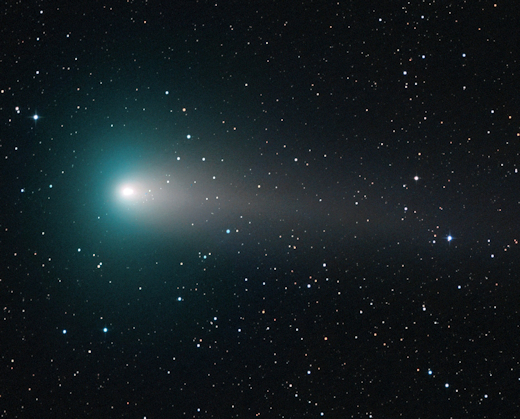
This comet is relatively small--its nucleus is barely more than a mile in diameter--but it is bright and active, and a frequent visitor to the inner solar system as it orbits the sun once every 6.6 years. On Sept. 10th, 21P/Giacobini-Zinner will not only be near Earth, but also at perihelion, its closest approach to the sun. Solar heating will make it shine like a star of 6th to 7th magnitude, just below the threshold of naked-eye visibility and well within range of common binoculars. Detailed sky maps will help you find it. 21P/Giacobini-Zinner is the parent of the annual Draconid meteor shower, a bursty display that typically peaks on Oct. 8th. Will the shower will be extra-good this year? Maybe. Draconid outbursts do tend to occur in years near the comet's close approach to the sun. However, not every close approach brings a meteor shower. Forecasters say there are no known Draconid debris streams squarely crossing Earth's path this year, so we will have to wait and see. Click to view an interactive 3D orbit of 21P/Giacobini-Zinner as it passes by our planet in 2018: 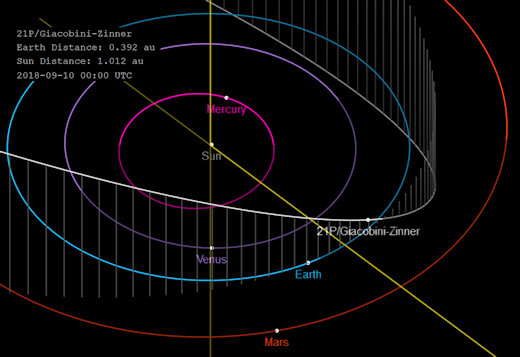
Note: "AU" means "astronomical unit." 1 AU is the distance between Earth and the sun. The distance to Comet 21P/Giacobini-Zinner on Sept. 10th will be ~0.39 AU or 58 million km. On the scale of things in the solar system, the comet will be close to Earth, but not scary-close. More resources: magnitudes; orbital elements; sky map. Realtime Comet Photo Gallery
FLY ME TO THE MOONSTONE: Are you looking for a far-out gift? Nothing says "I love you" like a moonstone from the edge of space. On Jan 27th, the students of Earth to Sky Calculus flew this moonstone wrapped in a hand-crafted sterling silver Celtic love knot 35.1 km (115,158 feet) above Earth's surface: 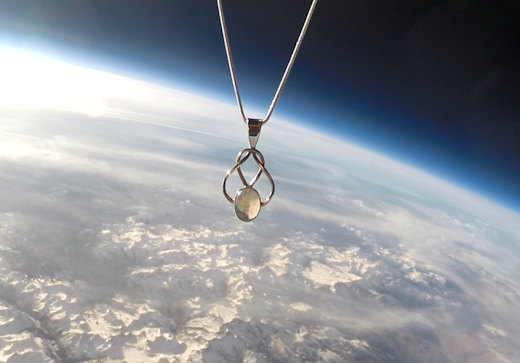
You can have it for $179.95. The students are selling these pendants to support their cosmic ray ballooning program. Each one comes with a greeting card showing the item in flight and telling the story of its journey to the edge of space. All sales support the Earth to Sky Calculus cosmic ray ballooning program and hands-on STEM research. Far Out Gifts: Earth to Sky Store
All sales support hands-on STEM education
Realtime Aurora Photo Gallery
Realtime Space Weather Photo Gallery Every night, a network of NASA all-sky cameras scans the skies above the United States for meteoritic fireballs. Automated software maintained by NASA's Meteoroid Environment Office calculates their orbits, velocity, penetration depth in Earth's atmosphere and many other characteristics. Daily results are presented here on Spaceweather.com. On Aug. 24, 2018, the network reported 24 fireballs.
(23 sporadics, 1 kappa Cygnid) 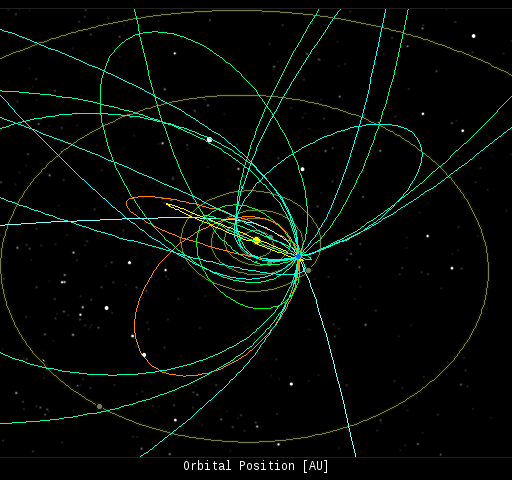 In this diagram of the inner solar system, all of the fireball orbits intersect at a single point--Earth. The orbits are color-coded by velocity, from slow (red) to fast (blue). [Larger image] [movies] Potentially Hazardous Asteroids ( PHAs) are space rocks larger than approximately 100m that can come closer to Earth than 0.05 AU. None of the known PHAs is on a collision course with our planet, although astronomers are finding new ones all the time. On August 24, 2018 there were 1912 potentially hazardous asteroids.
 | Recent & Upcoming Earth-asteroid encounters: | Asteroid | Date(UT) | Miss Distance | Velocity (km/s) | Diameter (m) | | 2018 QZ | 2018-Aug-19 | 6.6 LD | 9.5 | 53 | | 2018 QE | 2018-Aug-20 | 2.8 LD | 4.5 | 10 | | 2018 QA1 | 2018-Aug-21 | 12.3 LD | 11.2 | 77 | | 2018 PK9 | 2018-Aug-22 | 17 LD | 9 | 33 | | 2018 PW7 | 2018-Aug-23 | 11.3 LD | 10.6 | 49 | | 2018 QF1 | 2018-Aug-23 | 18.1 LD | 14.3 | 75 | | 2018 PU23 | 2018-Aug-23 | 7.8 LD | 1.5 | 8 | | 2018 PR9 | 2018-Aug-24 | 18.1 LD | 14 | 46 | | 2018 LQ2 | 2018-Aug-27 | 9.4 LD | 1.5 | 39 | | 2016 GK135 | 2018-Aug-28 | 16.8 LD | 2.8 | 9 | | 2016 NF23 | 2018-Aug-29 | 13.2 LD | 9 | 93 | | 1998 SD9 | 2018-Aug-29 | 4.2 LD | 10.7 | 51 | | 2018 DE1 | 2018-Aug-30 | 15.2 LD | 6.5 | 28 | | 2001 RQ17 | 2018-Sep-02 | 19.3 LD | 8.3 | 107 | | 2015 FP118 | 2018-Sep-03 | 12.3 LD | 9.8 | 490 | | 2018 QA | 2018-Sep-03 | 17.5 LD | 20.4 | 73 | | 2017 SL16 | 2018-Sep-20 | 8.5 LD | 6.4 | 25 | | 2018 EB | 2018-Oct-07 | 15.5 LD | 15.1 | 155 | | 2014 US7 | 2018-Oct-17 | 3.2 LD | 8.7 | 19 | | 2013 UG1 | 2018-Oct-18 | 10.4 LD | 13.4 | 123 | | 2016 GC221 | 2018-Oct-18 | 8.7 LD | 14.4 | 39 | Notes: LD means "Lunar Distance." 1 LD = 384,401 km, the distance between Earth and the Moon. 1 LD also equals 0.00256 AU. MAG is the visual magnitude of the asteroid on the date of closest approach. | | Cosmic Rays in the Atmosphere | SPACE WEATHER BALLOON DATA: Approximately once a week, Spaceweather.com and the students of Earth to Sky Calculus fly space weather balloons to the stratosphere over California. These balloons are equipped with radiation sensors that detect cosmic rays, a surprisingly "down to Earth" form of space weather. Cosmic rays can seed clouds, trigger lightning, and penetrate commercial airplanes. Furthermore, there are studies ( #1, #2, #3, #4) linking cosmic rays with cardiac arrhythmias and sudden cardiac death in the general population. Our latest measurements show that cosmic rays are intensifying, with an increase of more than 18% since 2015: 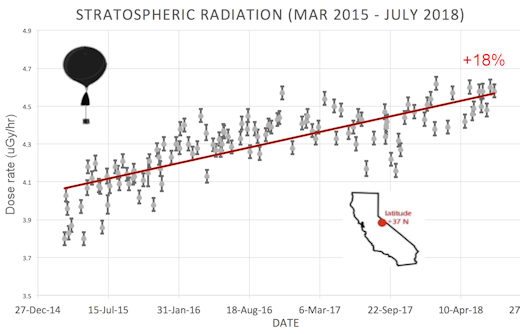
The data points in the graph above correspond to the peak of the Reneger-Pfotzer maximum, which lies about 67,000 feet above central California. When cosmic rays crash into Earth's atmosphere, they produce a spray of secondary particles that is most intense at the entrance to the stratosphere. Physicists Eric Reneger and Georg Pfotzer discovered the maximum using balloons in the 1930s and it is what we are measuring today. En route to the stratosphere, our sensors also pass through aviation altitudes: 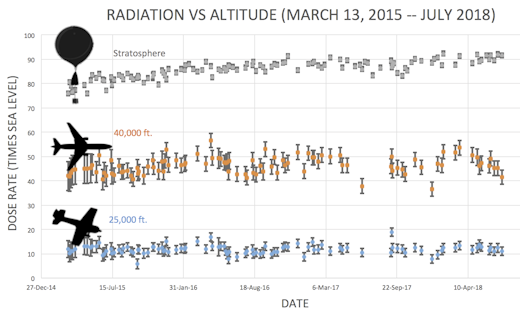
In this plot, dose rates are expessed as multiples of sea level. For instance, we see that boarding a plane that flies at 25,000 feet exposes passengers to dose rates ~10x higher than sea level. At 40,000 feet, the multiplier is closer to 50x. The radiation sensors onboard our helium balloons detect X-rays and gamma-rays in the energy range 10 keV to 20 MeV. These energies span the range of medical X-ray machines and airport security scanners. Why are cosmic rays intensifying? The main reason is the sun. Solar storm clouds such as coronal mass ejections (CMEs) sweep aside cosmic rays when they pass by Earth. During Solar Maximum, CMEs are abundant and cosmic rays are held at bay. Now, however, the solar cycle is swinging toward Solar Minimum, allowing cosmic rays to return. Another reason could be the weakening of Earth's magnetic field, which helps protect us from deep-space radiation. | | The official U.S. government space weather bureau | | | The first place to look for information about sundogs, pillars, rainbows and related phenomena. | | | Researchers call it a "Hubble for the sun." SDO is the most advanced solar observatory ever. | | | 3D views of the sun from NASA's Solar and Terrestrial Relations Observatory | | | Realtime and archival images of the Sun from SOHO. | | | from the NOAA Space Environment Center | | | fun to read, but should be taken with a grain of salt! Forecasts looking ahead more than a few days are often wrong. | | | from the NOAA Space Environment Center | | | the underlying science of space weather |  | If you are a Youtuber and want to buy real Youtube views than try out Buyrealsocial.com for the best results possible! |  | To find reviews of new online casino sites in the UK try The Casino DB where there are hundreds of online casino reviews complete with bonuses and ratings. | | | These links help Spaceweather.com stay online. Thank you to our supporters! | | | | | | | | |  | |  |   | ©2017 Spaceweather.com. All rights reserved. This site is penned daily by Dr. Tony Phillips. | |

